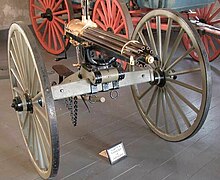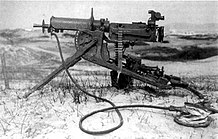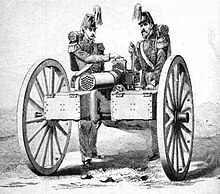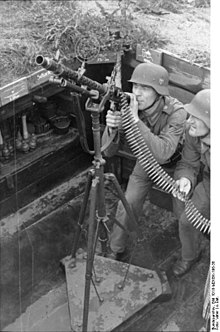Machine gun


A machine gun ( MG for short , in the Swiss Army Mg ) is a fully automatic firearm for firing rifle ammunition .
Machine guns fire upon actuation of the trigger as long as projectiles from, released again until the trigger, the ammunition supply is interrupted or a fault occurs. The automatic loading mechanism is operated either by the gas pressure of the expanding powder gases , by the recoil force or by an external drive such as an electric motor. MGs are considered war weapons in the Federal Republic of Germany . Trade and possession of machine guns in Germany are regulated by the War Weapons Control Act.
Machine gun calibres range from 5.56 mm to approx. 15 mm or a maximum of 20 mm (see list of small arms ammunition ). Fixed machine guns or machine guns mounted on mounts with a caliber of 12 to less than 20 mm are called heavy machine guns . Automatic firearms with a caliber of 20 mm or more are machine cannons and usually fire grenades instead of solid bullets. Fully automatic weapons that fire pistol ammunition fall under the name of submachine guns and are usually smaller than machine guns.
history
precursor

Early forerunners of the machine gun were the Ribauldequins , which were already used in the Middle Ages and were designed by Leonardo da Vinci , among others . The development of the modern machine gun did not begin until the volley guns of the 19th century, such as the mitrailleuse , a fast-firing gun in rifle caliber , which was first developed in Belgium in the 1850s . The mitrailleuse with its many rigid individual barrels, however, required an extensive reloading process by the operating team after each salvo.

Another forerunner for machine guns was the rifle designed by a Swiss named Steuble in the 1830s. He tried to sell it to the English, Russian and French governments but was unable to do so for various reasons.
The repeating guns, such as the Union Repeating Gun (also known as the Ager Gun or Mills Gun ) introduced around 1860 and the Gatling Gun patented by Richard Jordan Gatling in 1862 , represented a new development , with which, at least in theory, a continuous supply of ammunition was possible with the help of a crank-driven loading mechanism was. The latter was also characterized by the rotating barrel set , which prevented overheating problems. Both weapons came into limited use in the American Civil War . In 1865, Gatling patented the design of a six-barrel weapon that was capable of firing 200 rounds per minute .
First developments

In 1885, Hiram Maxim presented the first machine gun, the so-called Maxim Gun , in which the recoil of the shot was used to eject the empty cartridge case, tension the spring and load a new cartridge into the chamber ( recoil loader ). The ammunition was supplied here for the first time via cartridge belts , and water cooling was also new. The Maxim MG thus achieved a rate of fire of up to 600 rounds per minute. In the British colonial wars of 1893, especially in the Matabele Kingdom in Africa, the Maxim machine gun proved its worth, so that all military powers introduced machine guns of the Maxim type around the turn of the century. The next deployment took place in 1904 by the Imperial Russian Army in the Russo-Japanese War .
Other designers, John Moses Browning with his Colt model 1895 , Benjamin Hotchkiss based on the invention of the Austrian baron Adolf Odkolek von Újezd , Colonel Isaac Lewis and others developed machine guns as gas pressure loaders . Some of the propellant gases are diverted during the shot through a hole in the barrel in order to operate the reloading mechanism.
A third variant were the weapons with delayed mass locking from Schwarzlose , which, however, did not prove themselves at the beginning because the locking was not rigid and the barrels had to be short to reduce the residual pressure, otherwise functional problems would arise. The problems of weapons with delayed mass locking were only solved towards the end of the Second World War ( MG 45 , CETME , G3 , SIG 510 , SIG 710, Franz. AA-52) by milling relief grooves in the front part of the chamber. This avoided sleeve tears as the gas pressure on the tapered inner and outer surfaces of the sleeve was equalized.
The Danish Madsen MG was based on a completely different principle . In contrast to the designs mentioned above, the slide does not move parallel to the barrel axis, but rather folds down to feed the cartridge and up to eject the case. Infeed and ejected using levers activated by the return of the system. The Madsen MG is derived from the Peabody Martini system . The Russian cavalry received light Madsen machine guns manufactured in Denmark as early as 1904.
Development in the First World War
Germany

Years before the First World War , the German Reich set up machine gun departments with water-cooled machine guns of the Maxim type, in particular the MG 08 , which was shot from a mount . Shortly after the start of the war, however, it was supplemented by the MG 08/15 , which had a rifle butt and a bipod support. In terms of function, it corresponded to the MG 08, but was built lighter and intended for mobile use. Like the MG 08, it fired the belted rifle cartridge caliber 7.92 mm .
France
The machine gun of the French army was the St. Étienne M1907 and the air-cooled gas pressure loader Hotchkiss M1914 in caliber 8 mm Lebel . The cartridge was fed through loading strips . The Chauchat Mod. 1915 light machine gun fired the same cartridge from a banana-shaped magazine. It was a recoil and had a rate of just under 400 rounds per minute. It could easily be carried by a single soldier and was notorious for its inaccuracy and unreliability.
United Kingdom
The British Vickers heavy machine gun functionally corresponded to the Maxim, but in contrast to this, the knee joint buckle kinks upwards, which allows a lower design of the breech block. The British used the air-cooled gas pressure loader Lewis as a light machine gun . This had a top mounted plate magazine with 47 circularly arranged cartridges.
United States
The heavy water-cooled Browning M1917 US machine guns were only used sporadically in World War I, the US troops were equipped with French and British machine guns in US caliber .30-06 Springfield .
In the last months of the war the (fully) automatic rifle Browning Automatic Rifle (BAR) Mod. 1918 , a gas pressure loader with a 20-round box magazine, was introduced into the troops. However, it was only given a bipod after the end of the war and only then became a light machine-gun.
The United States copied the cartridge from an anti-tank rifle from Mauser, which was captured at the end of the war , redesigned it to inch dimensions and created the super-heavy MG M2 in .50 caliber (12.7 mm), which is still in use today, more or less further developed, worldwide is.
This Browning MG corresponds to the functionality of the smaller water-cooled MG Mod. 1917 in caliber .30 and its air-cooled variant M1919 . All of these weapons are belt-fed blowback loaders.
All American Browning weapons were still in use during the Korean War .
Later developments
The traditional division into light and heavy machine guns became obsolete in the German Wehrmacht with the introduction of the MG 34 . This served as a universal machine gun that was used either with a bipod or on a tripod mount. Although the MG 34 was very powerful, because of its many turned and milled parts, it was very expensive to manufacture and sensitive to dirt and cold. These disadvantages were remedied by a radical redesign with the MG 42 , which to this day sets a benchmark in terms of simplicity, robustness, functional reliability under all conditions and low manufacturing costs. For the first time, the technique of stamping and punching weapon parts was used on a large scale. In addition, there was the roller-supported breech, which enabled a rate of fire of 1500 rounds / min. In practice, the rate of fire was 1200 rounds / min. lowered in order to keep tube wear and ammunition consumption within limits. This weapon was designed in a factory that manufactured office lamps ( Johannes Großfuß KG , Döbeln ).
The standard machine gun of the German Bundeswehr today is the MG3 , a successor to the MG 42 of the Wehrmacht. It is air-cooled and, like the MG 42, was mainly manufactured using sheet metal stamping. As a supplement and successor to the MG3, the MG4 and MG5 are introduced in the Bundeswehr . A further development of the MG 42, the MG 74 , is also used in the Austrian Armed Forces .
The famous American M60 machine gun is also a development, some of which are based on the MG 42; it has since been replaced by the M249 SAW in most of the army.
Structure and technology
In terms of structure, rifles and machine guns differ primarily in the way the reloading mechanism of the weapon works and the locking technology . The basic structure is otherwise identical. With heavy machine guns, the use of the ammunition belt is another special feature compared to (automatic) rifles. A belt enables a higher rate of cadence compared to conventional ammunition feed with a magazine.
A machine gun design that deviates from the current principle is the modern Gatling weapon . With these types of machine guns, multiple rotating barrels during the rotation cycle each have a fraction of a second to cool down. This means that there is no longer just one single run that is permanently stressed. In addition, the rotation of the barrel set causes air to flow around the barrels, which improves cooling. Machine guns that work with ammunition belts generally require special barrel cooling , as the steel of the barrel would otherwise burn out and wear out due to the high rate of fire. In the past, water was often used for cooling, today the barrels are either changed regularly after a number of belts or replaced entirely.
Model types
Within the group of machine guns, a further differentiation is made between light, medium and heavy machine guns.
- Light machine guns (IMG) are characterized by the fact that they can be transported by a soldier alone and also shot free-hand and are not much heavier than the respective standard weapons. The ammunition is usually fed via magazines , but belt feed is also possible. The barrel of most light machine guns is not replaceable and is permanently installed. While earlier than yet more loading rifles were orderly, LMG's own line of development were (eg. BREN ) or a slight variation from the universal machine gun ( MG 42 were derived), are nowadays often variations of popular assault rifles of the same caliber, with a heavier barrel and bipod equipped are used. Examples are the Soviet RPK or the Swiss LMg 25 .
- Medium machine guns - also called multi-purpose machine guns or universal machine guns - are not based on an assault rifle, but are usually a development of their own. In these weapons, more powerful cartridges with a larger caliber than in assault rifles may be used. Multi-purpose machine guns can be used both as a light machine-gun with a bipod, and as a heavy machine-gun on a mount. Other key features for medium machine guns are:
- Heavy machine guns are machine guns that are permanently installed ormountedon mounts . These are either medium-sized MGs or separate developments for special applications. Gatling machine guns are generally classified as heavy machine guns due to their high weight, high recoil force and the enormous amount of ammunition they consume.
Occasionally one also finds the designation super- heavy machine guns , mostly for heavy machine guns with a caliber of 12.7 mm and higher. An example of this is the Soviet KPW in caliber 14.5 × 114 mm .
commitment
The light machine guns (and medium machine guns on bipods) are classed as handguns because they can be operated by one person. However, the shooter is often supported by someone else when transporting the ammunition. They are mostly used as group machine guns in an infantry unit or as on-board armament in military vehicles.
Heavy machine guns (and correspondingly mounted medium machine guns) are mostly used for arming, for example, combat aircraft , combat helicopters or tanks , but also for defending fortified positions. Since they cannot be carried or can only be dismantled (in weapon and carriage) and cannot be operated by one person without problems, heavy machine-guns are not classed as handguns.
Use with ground units
In combat operations, machine guns are mainly used to give support fire and to hold down the actions of the enemy (fire protection - barrage ).
One of the first major operations with machine guns was the suppression of the Mahdi uprising (1881 to 1899). The Mahdists were defeated by an Anglo-Egyptian force in 1898. This counted 482 killed and wounded, the Mahdi side 9,700 dead and 16,000 wounded.
The bloody positional battles in World War I were due to the use of machine guns on both sides. The strategy and tactics of warfare changed fundamentally. Most of the attacks quickly collapsed due to the crossfire with machine guns on the long front. For example, in the Battle of the Somme, 90% of British casualties were due to German machine gun fire.
During the Second World War , the machine gun squad of each rifle group of the Wehrmacht consisted of up to four soldiers. The first ammunition equipment included 2500 rounds as planned. The machine gunner carried 50 rounds in a belt drum, 500 rounds each for machine gunner 2 and 3. The rest was carried in the war train. In practice, however, this ammunition was also distributed among the riflemen in the group and carried with them, and the assignment of a machine gunner 3 was soon dropped. The machine-gunmen went to carry up to four exchangeable tubes with them in order to be able to hold down enemy forces in defense but also in attack in longer battles, since the tube had to be changed to cool down after every 150 rounds fired. In the sMG troops of the MG companies of the infantry battalions, the MGs were used on field tripods. This also made it possible to take fire up to 1200 m further away, some with an archery shot. Tracer cartridges were also used for the MG to observe the firing position, especially at night and for anti-aircraft defense. For this purpose, the ratio of 1 shot of tracer to 3 shots of normal ammunition should be strapped.
In practice, the aim is to fight the enemy with short, targeted bursts of fire. Continuous fire with an operation of 250 rounds and more is only useful with field mounts and must be accompanied by changing the barrel, as otherwise the barrel overheats and a projectile can become jammed in the barrel and cause the barrel to burn out.
Use in aerial combat
First World War
Machine guns were first used as aircraft on-board weapons during the First World War . On the German side, modified MG 08 and later MG 08/15 were used. The modifications consisted in doing without the water jacket, since the airflow was enough to cool the barrel. A German innovation were synchronized machine guns that could shoot through the propeller circle with the help of an interrupter gear. This increased the accuracy. In fighter planes , two of these machine guns were usually arranged rigidly above the engine. French fighters also shot through the propeller circle, but unsynchronized. For this purpose, the propeller blades had to be covered with sheet steel, on which the lead bullets ricocheted off, which limited both the firepower and the performance of the machine.
The Parabellum MG was also used primarily in mobile installations .
Second World War
At the beginning of the Second World War all powers used small-caliber machine guns (7.5–7.92 mm) in their aircraft. Due to insufficient penetration and range, these were soon replaced by super-heavy machine-guns (12.7–13.2 mm) or machine guns of larger caliber.
Since 1945
The last aircraft to carry MGs as their main armament were the American F-86s . Nowadays, machine guns are only used by light combat aircraft and helicopters. Otherwise, the use of machine guns is preferred due to the significantly higher effect in the target.
Legal situation
Situation in Germany
In Germany, private individuals are prohibited from owning fully automatic weapons.
Situation in Switzerland
In Switzerland, machine guns which can be carried and operated by a single person fall under Article 5 of the Weapons Act, the term series firearms, the acquisition and possession of which is prohibited. This also applies to those that have been converted into semi-automatic weapons. The law also prohibits shooting with series firearms. The cantonal authorities may, in justified individual cases, e.g. B. for collectors, issue special permits. These permits contain regulations that are regularly checked by the authorities. For example, the breech and the weapon must be kept "spatially separated and protected from third-party access".
literature
- FWA Hobart: The machine gun. The story of a fully automatic weapon. 3. Edition. Motorbuch-Verlag, Stuttgart 1976, ISBN 3-87943-277-5 .
- Daniel Musgrave: German machine guns. Development, technology, types. Motorbuch-Verlag, Stuttgart 1995, ISBN 3-613-01653-2 .
- Eugen A. Lisewski: German machine guns in use. MG 01 to MG 42. Podzun-Pallas Verlag, Wölfersheim-Berstadt 1999, ISBN 3-7909-0681-6 ( Das Waffen-Arsenal, Vol. 180).
- Rolf Wirtgen : The development of the machine gun. From the hand tube to the universal machine gun. Brochure for the special exhibition 2005 at the Defense Technical Study Collection . Federal Office for Defense Technology and Procurement, Koblenz 2005, ISBN 3-927038-66-0 .
- Ilya Shaydurov: Russian firearms - types.Technology.Data. Motorbuch Verlag, Stuttgart 2010, ISBN 978-3-613-03187-6 .
- Chris McNab: MG 34 and MG 42 Machine Guns , Bloomsbury Publishing, 2012, ISBN 978-1-78200-309-0 . 82 pages (online PDF) ( Memento from May 15, 2018 in the Internet Archive )
Web links
- Overview of all MGs up to 20 mm
- How Machine Guns Work (English)
- James Puckles machine gun (English)
Individual evidence
- ↑ G Lenotre: Vieilles Maisons, Vieux paper ( fr ). Tallandier, 2014, ISBN 979-1-02-100758-1 , p. 81.
- ↑ La Presse ( fr ) May 22, 1838. Retrieved August 26, 2019.
- ↑ The Mohammedan Movement in Egyptian Sudan . Lecture by Professor Dr. Dagobert Schoenfeld , 1904
- ↑ Rozina Sabur, Laurence Dodds: Ten facts about the Battle of the Somme , The Telegraph, July 30, 2016
- ↑ Appendix 2 (to Section 2 Paragraphs 2 to 4) Weapons List, Section 1 (Prohibited Weapons), 1.2.1.1. (Fully automatic machines)







